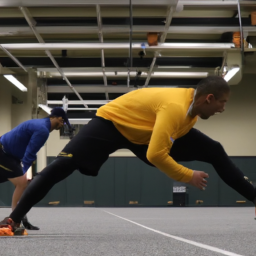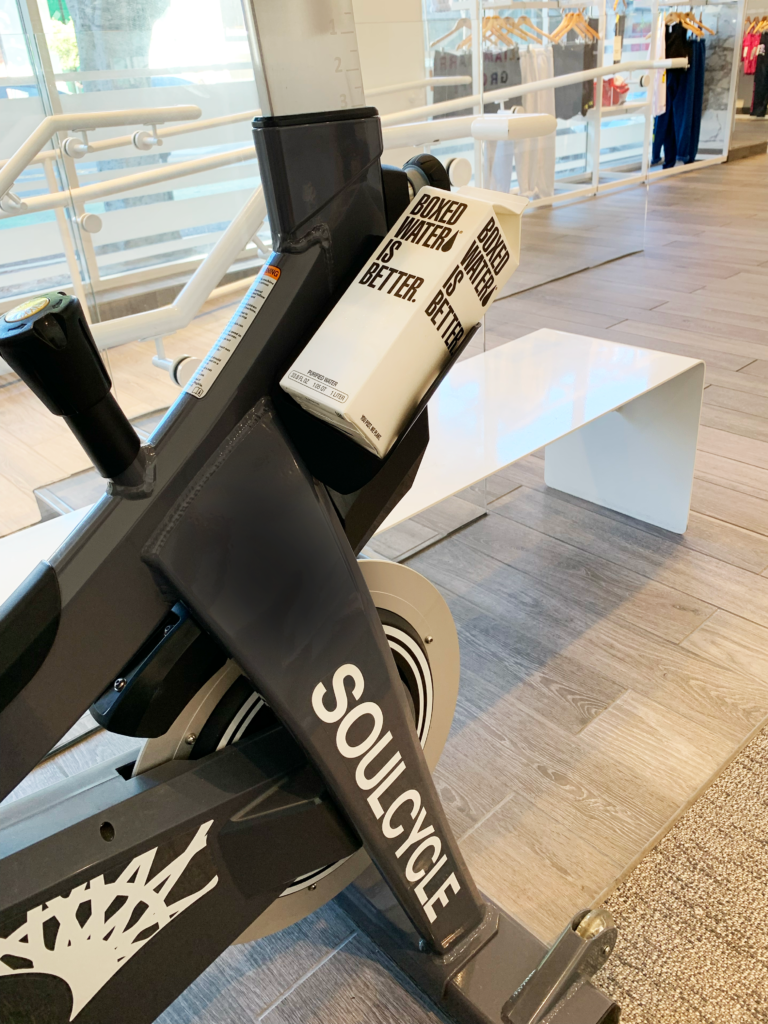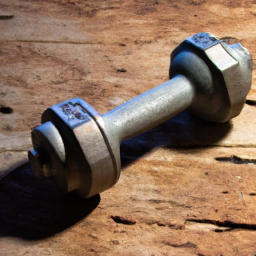In this article, we’ll be discussing the importance of pre-workout stretches and how they can help prevent injuries and enhance your performance. You’ll learn about the different types of stretches that are beneficial before a workout and why they are important. We’ll also provide you with some examples of effective pre-workout stretches that you can incorporate into your routine. By the end of this article, you’ll have a better understanding of the best pre-workout stretches to implement in order to stay injury-free and optimize your workout performance. So let’s get started!
What are Pre-Workout Stretches?
Importance of Stretching Before Workouts
Before diving into the specifics of pre-workout stretches, it is essential to understand the importance of incorporating stretching into your fitness routine. Stretching before workouts helps prepare your mind and body for the physical demands to come, reducing the risk of injury and improving overall performance.
Definition of Pre-Workout Stretches
Pre-workout stretches are exercises designed to warm up the muscles and increase flexibility before engaging in physical activity. These stretches aim to improve joint range of motion, increase blood flow to the muscles, and loosen up any tightness or tension. They are typically performed prior to any workout, be it cardio, strength training, or flexibility exercises.
Benefits of Incorporating Pre-Workout Stretches into Your Routine
Incorporating pre-workout stretches into your fitness routine offers numerous benefits that can significantly impact your performance and overall well-being. Some of the key advantages include:
-
Improved Flexibility: Regular stretching before workouts can help increase joint flexibility, allowing for a greater range of motion during exercises.
-
Reduced Risk of Injury: Pre-workout stretches help warm up the muscles, ligaments, and tendons, reducing the risk of strains, sprains, and other exercise-related injuries.
-
Enhanced Muscle Performance: By increasing blood flow and activating the muscles through stretching, you can achieve better muscle performance, power, and explosiveness during your workouts.
-
Decreased Muscle Soreness: Stretching before exercise can help reduce muscle tension, minimizing post-workout soreness and improving recovery time.
-
Improved Body Awareness: Pre-workout stretches promote body awareness and mind-muscle connection, allowing you to perform exercises with better form and technique.
Different Types of Pre-Workout Stretches
There are numerous types of pre-workout stretches, each targeting different muscle groups and providing unique benefits. Here are some common types of stretches you can incorporate into your routine:
Static Stretches
Static stretches involve holding a stretch for an extended period, typically around 15-30 seconds. These stretches help elongate the muscles and improve flexibility. Examples include standing hamstring stretches and chest stretches.
Dynamic Stretches
Dynamic stretches involve continuous movement and active muscle engagement. These stretches help increase blood flow and warm up the muscles. Examples include walking lunges, arm circles, and high knees.
Active Stretches
Active stretches involve using one muscle group to stretch another. These stretches help increase flexibility and promote better muscular coordination. Examples include quad stretches where you use your hand to pull your foot towards your glutes.
Passive Stretches
Passive stretches involve an external force or prop to stretch a muscle. These stretches help improve muscle length and promote relaxation. Examples include using a strap or towel to assist in hamstring stretches.
Proprioceptive Neuromuscular Facilitation (PNF) Stretches
PNF stretches involve a combination of stretching and contracting muscles, with the aim of improving flexibility and range of motion. These stretches are usually done with a partner or using resistance equipment. Examples include contract-relax stretches and hold-relax stretches.
Proper Technique for Pre-Workout Stretches
To maximize the benefits of pre-workout stretches and minimize the risk of injury, it is essential to follow proper stretching techniques. Here are some key considerations:
Warm-Up Before Stretching
Before diving into static stretches, it is crucial to warm up the body with dynamic movements such as light jogging, jumping jacks, or arm swings. This helps increase blood flow and raises the core body temperature, preparing the muscles for stretching.
Maintaining Proper Form
When performing pre-workout stretches, it is essential to maintain proper form and alignment. Each stretch should be performed with controlled and smooth motions, avoiding any jerking or bouncing movements that can strain the muscles.
Duration and Intensity of Stretches
For static stretches, hold each stretch for around 15-30 seconds, aiming for a mild to moderate stretch sensation without discomfort. Gradually increase the intensity of the stretch as the muscles begin to loosen up.
Breathing Techniques During Stretches
Maintain slow and controlled breathing during each stretch, focusing on deep inhalations and exhalations. Avoid holding your breath, as it can lead to muscle tension and reduce the effectiveness of the stretch.
Avoiding Overstretching or Bouncing
Overstretching or bouncing during stretches can lead to muscle strains and injuries. Instead, focus on gradual and gentle stretching, respecting your body’s limitations and avoiding any pain or discomfort.
Specific Pre-Workout Stretches for Different Muscle Groups
To target specific muscle groups and prepare for different types of workouts, here are some pre-workout stretches you can incorporate into your routine:
Neck and Shoulder Stretches
- Neck rotations: Slowly rotate your head in circles, both clockwise and counterclockwise, to release tension in the neck.
- Shoulder rolls: Roll your shoulders back and down in a slow, controlled motion to warm up the shoulder muscles.
Chest and Upper Back Stretches
- Chest opener stretch: Interlace your fingers behind your back and gently lift your arms, squeezing the shoulder blades together.
- Upper back stretch: Extend your arms forward and round your upper back, stretching between the shoulder blades.
Lower Back Stretches
- Child’s pose: Kneel on the ground, sit back on your heels, and slowly lower your upper body forward, reaching your arms out in front of you.
- Cat-cow stretch: Get on all fours, arch your back up towards the ceiling like a cat, and then relax your back and let your belly sink towards the ground.
Hamstring and Calf Stretches
- Standing hamstring stretch: Stand with one leg extended straight in front of you, resting your foot on a raised surface, and gently lean forward to feel the stretch in the hamstring.
- Calf stretch: Stand facing a wall, place one foot a step behind you, keeping the heel on the ground, and lean forward to stretch the calf muscle.
Quadriceps and Hip Flexor Stretches
- Standing quad stretch: Standing on one leg, bend the other knee and grasp the ankle, gently pulling the foot towards your glutes.
- Lunges: Step one leg forward, bend both knees, and lower your body until you feel a stretch in the front of the hip and thigh.
Pre-Workout Stretches for Common Exercises
Depending on the type of exercise you will be engaging in, there are specific pre-workout stretches that can help prepare your body for optimal performance. Here are some examples:
Running and Jogging
- Leg swings: Stand near a wall or support, swing your leg forward and backward, keeping it straight.
- Walking knee hugs: As you walk forward, bring each knee up towards your chest, hugging it with both hands.
Weightlifting and Strength Training
- Shoulder dislocations: Hold a resistance band with both hands, and slowly raise your arms overhead and behind your body, keeping them straight.
- Deep squats: Lower your body into a deep squat, holding onto a support if needed, focusing on keeping your heels on the ground and chest lifted.
Yoga and Flexibility Workouts
- Spinal twists: Sit on the ground with your legs extended, twist your torso to one side, placing your opposite hand on the outside of your thigh.
- Butterfly stretch: Sit on the ground, bring the soles of your feet together, and gently press your knees towards the ground using your hands.
Cycling and Spinning
- Hip flexor stretch: Stand with one foot forward and one foot back, bend both knees slightly, and press your hips forward until you feel a stretch in the front of the hip.
- Standing quad stretch: Stand on one leg, bend the opposite knee, and reach back to grasp the ankle, gently pulling it towards your glutes.
HIIT (High-Intensity Interval Training) Exercises
- Arm circles: Extend your arms straight out to the sides, and make small circles with your hands in a forward motion, gradually increasing the size of the circles.
- Standing forward fold: Stand with feet hip-width apart, bend at the waist, and fold forward, reaching towards your toes.
Preventing Injuries Through Pre-Workout Stretches
Incorporating pre-workout stretches into your fitness routine is an effective way to prevent injuries by promoting better body mechanics and physical readiness. Here are some ways in which pre-workout stretches can help prevent injuries:
Improving Joint Flexibility and Range of Motion
Regular stretching before workouts helps improve joint flexibility, allowing for a greater range of motion during exercises. This increased mobility reduces the risk of strains and sprains.
Increasing Blood Flow and Circulation
Pre-workout stretches increase blood flow to the muscles, delivering oxygen and essential nutrients. This enhanced circulation helps warm up the muscles and prepares them for action.
Reducing Muscle Tension and Soreness
Stretching before exercise helps reduce muscle tension and increase blood flow to the muscles, minimizing post-workout soreness and improving recovery time.
Enhancing Coordination and Balance
Pre-workout stretches promote body awareness, coordination, and balance. This enhanced proprioception helps prevent stumbles and falls during workouts.
Preventing Muscle Imbalances and Postural Issues
Pre-workout stretches help lengthen tight muscles and correct muscle imbalances. This reduces the risk of injuries caused by poor posture and overcompensation.
Enhancing Workout Performance with Pre-Workout Stretches
Beyond injury prevention, incorporating pre-workout stretches into your fitness routine can significantly enhance your overall workout performance. Here’s how:
Activating and Priming the Muscles
Pre-workout stretches activate and prime the muscles for physical activity, allowing them to contract and relax more effectively during workouts.
Improving Muscle Power and Explosiveness
Dynamic pre-workout stretches help improve muscle power and explosiveness, allowing you to generate more force and energy during exercises.
Increasing Exercise Efficiency
Increased joint flexibility and range of motion achieved through pre-workout stretches help optimize exercise techniques and movements, leading to better overall workout efficiency.
Enhancing Body Awareness and Mind-Muscle Connection
By incorporating pre-workout stretches, you can improve your body awareness and mind-muscle connection, ensuring that each muscle group is properly engaged during exercises.
Boosting Mental Focus and Concentration
Pre-workout stretches provide an opportunity to focus, calm the mind, and mentally prepare for the upcoming physical activity, enhancing concentration and focus.
Timing of Pre-Workout Stretches
While pre-workout stretches are an integral part of any fitness routine, the timing and application can vary depending on several factors. Here are some considerations:
Pre-Workout Stretches in the Warm-up Phase
Pre-workout stretches should be performed after a general warm-up, which usually consists of 5-10 minutes of low-intensity exercise like walking or light jogging. This raises the core body temperature and increases blood flow to the muscles.
When to Avoid Static Stretches
Avoid static stretches immediately before exercises that require explosive power or strength, such as sprinting or heavy weightlifting. Static stretches can temporarily reduce muscle power, potentially affecting performance.
Pre-Workout Stretches for Different Workout Durations
For shorter workouts, spend around 5-10 minutes on pre-workout stretches. For longer, more intense workouts, dedicate 10-15 minutes to pre-workout stretches to adequately prepare the body.
Adjusting Stretches Based on Exercise Intensity
Consider the intensity of your upcoming workout when selecting pre-workout stretches. For example, if you plan on running, focus on stretches that open up the hips and mobilize the ankles.
Post-Stretching Cooldown and Recovery
After completing your workout, perform post-workout stretches or cooldown exercises to gradually bring your heart rate down and help your body recover. These stretches can help reduce post-workout muscle soreness.
Incorporating Pre-Workout Stretches Into Your Fitness Routine
To make the most out of pre-workout stretches, it is essential to incorporate them into your fitness routine consistently. Here are some tips for doing so:
Designing a Pre-Workout Stretching Routine
Create a customized pre-workout stretching routine that targets specific muscle groups and considers the type of exercise you will be engaging in. Experiment with different stretches to find what works best for you.
Choosing the Right Stretches for Your Needs
Focus on choosing stretches that address your specific needs and target tight or problem areas in your body. Consult a fitness professional or physical therapist for guidance on appropriate stretches for your unique circumstances.
Progressing and Modifying Stretches Over Time
As your flexibility improves, gradually progress the intensity and duration of your stretches. Incorporate more challenging stretches over time to continue improving your range of motion.
Finding Balance Between Stretching and Other Warm-Up Exercises
While pre-workout stretches are essential, remember to include a variety of warm-up exercises such as joint mobility work, balance exercises, or light cardio activities to warm up the body holistically.
Making Pre-Workout Stretches a Habit
Consistency is key when it comes to incorporating pre-workout stretches into your fitness routine. Make stretching a habit by setting aside specific times each day to devote to your stretching routine.
Conclusion
Incorporating pre-workout stretches into your fitness routine is a crucial step towards preventing injuries, enhancing performance, and improving overall well-being. By selecting appropriate stretches, maintaining correct form, and gradually progressing your routine, you can unlock the full potential of your workouts. Remember to customize your stretching routine based on your specific needs and consult professionals when necessary. Set aside time for pre-workout stretching, and make it a habit to prepare your mind and body for optimal performance.


